
Marketing Channel of the Freshwater Mud Eels in Northern Region of Bangladesh and Its Pre-Export Processing Activities
*Corresponding Author(s):
Kazi Ahsan HabibDepartment Of Fisheries Biology And Genetics, Sher-e-Bangla Agricultural University, Dhaka, Bangladesh
Tel:+880 244814069/ +880 1713682290,
Email:ahsan_sau@yahoo.com
Abstract
The present study has been undertaken to create a better understanding by reviewing the current marketing channel and pre-processing activities of fresh water mud eel (Monopterus cuchia) before exporting in Northern regions of Bangladesh (Bogra, Rangpur and Dinajpur district) for a period of three months (November to January) of each year from 2016-18. For the fiscal year of 2015-16 all the channels of marketing were observed while for the years of 2016-17 and 2017-18 only amount of collection was dealt. A total of 64 harvesters were randomly selected for the study. The data were collected using well-structured questionnaire and checklist from the selected area. The marketing chain passes through a number of intermediaries from harvesters to exporters and finally exports to the foreign countries. From the survey, it was found that the smaller (50 g to 250 g per piece) mud eels have higher price as BDT 300/kg than larger one (above 250 g) as price BDT 240/kg. Highest abundance was found in March to December. Mud eel marketing was considered as a profitable and feasible business by most of the marketing operators. But price of freshwater mud eel is yet to be fixed; it changes on daily basis based on demand and supply. Exporting of Mud eel from Bangladesh is supposed to rise as international demand of mud eel is increasing day by day. Small processing has been done in different processing areas on the basis of processing and packaging of the products through internet by foreign buyers. Based on various factors, it could be concluded that marketing system in the study areas are not well developed.
Keywords
Foreign Earnings; Harvesters; Monopterus cuchia; Synbranchiformes
INTRODUCTION
Bangladesh is an Argo-based country and Fisheries is one of the sub-sectors of agriculture which plays an important role in the economy of this country. According to FAO report The State of World Fisheries and Aquaculture 2018, Bangladesh ranked 3rd in inland open water capture production and 5th in world aquaculture production. Shrimp is the main fisheries export item in Bangladesh but recently it loses its market for many reasons. So, it is time to explore alternate exportable fishery products. In this regard, freshwater mud eel could be the best option. It is an air breathing eel locally known as kuchia or kuicha, belongs to the family Synbranchidae of the order Synbranchiformes [1]. It is also found in brackish water. This fish is very tasty and nutritionally rich with medicinal value and has high price in foreign market [2]. An existing annual country production was found to be more than 364.57 t in which highest obtained from Borguna district (43.91 t) and it was 12.05 % of the total production. Highest annual production (245.11 t/year) was recorded in the freshwater districts whereas coastal areas produced 117.43 t/ year [3]. In recent years, it is considered one of the potential export items particularly among fisheries products. According to Export Promotion Bureau (EPB) of Bangladesh in 2017-18 fiscal years, Bangladesh earned 15 million USD by exporting 70.0175 tons cuchia. Bangladesh exports cuchia in 17 countries including Taiwan, China, Honkong, Singapore and Malaysia [4]. It is commercially important due to its availability, high demand for export and the value of earnings has been steadily increasing yearly [5]. Freshwater mud eel is available commonly in open water resources and it can tolerate various adverse environmental conditions. The availability of this species in nature has abruptly declined due to various natural and man-made causes such as high fishing pressure, habitat destruction, aquatic pollution by industrial wastes and indiscriminate uses of pesticides [6]. Nowadays, availability of this fish is decreasing in the nature of Bangladeshi. It can generate employment opportunity directly and indirectly in terms of people employed in the marketing and other associated business while more than 8,000 fishers, traders, transporters and exporters are found to be involved in this sector [7]. Marketing system of mud eel is not well developed and thus the fishermen are deprived from the proper price of it. So, selection of North Bengal (Bogra, Rangpur and Dinajpur) district as the study area is much more sensible to know the marketing system of freshwater eel. However, there is no reliable data about the marketing channel of the mud eel in the North Bengal region. Therefore, a comprehensive study was designed to determine the marketing channel and export processing system of the freshwater mud eels in that region.
MATERIALS AND METHODS
The study was conducted in a pre-selected area among the major mud eel production zones, North Bengal region (Bogra, Rangpur and Dinajpur district) of Bangladesh (Figure 1). Because mud eel is available in this area and collectors collect it from that region in regular basis. According to Chambers (1992), the area in which a business survey is to be carried out depends on the particular purpose of the study and possible cooperation from the local people [8]. In this regard selection of North Bengal region is perfect. The study was conducted in two phases. In first phase the data were collected for the periods of three months from November 2015 to January 2016 and in second phase the data were collected during November to January of each year of 2017 to 2018. The study was based on both primary and secondary data. A total of 64 harvesters and exporters were randomly selected in three districts for the study. The primary data were collected through direct interview using a well-structured questionnaire from respondents while secondary data were collected from Exporter’s society regarding export volume and earnings and from different books, web articles, published reports, papers and some official documents, journals regarding the marketing channel of freshwater mud eels. After collecting, the data were computed, edited, coded, summarized and processed for analysis. These data were verified to eliminate all possible errors and inconsistencies. All the collected data were accumulated and analyzed by Microsoft Excel program and then presented the results as tabular and graphic form.
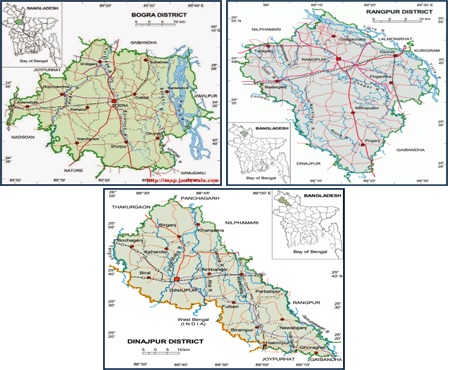 Figure 1: Map showing the study area (Bogra, Rangpur and Dinajpur districts of Bangladesh).
Figure 1: Map showing the study area (Bogra, Rangpur and Dinajpur districts of Bangladesh).
FRESHWATER MUD EEL’S MARKETING CHANNEL
Harvesters
Harvesters are those who collect cuchia from wild sources and sell them to local agents who are popularly known as a bapari. Sometimes harvesters sell cuchia directly to local market.
Local agents
Local agents directly buy eel from harvesters and sell it to the collectors. Local agents based on local market near to harvesting areas.
Collectors
There are two types of collectors; small and large. Both small and large collectors collect cuchia from local Agents. Besides this, large collectors collect cuchia from local market. Collectors sell it to the suppliers.
Suppliers
Suppliers collect cuchia from collectors and they transfer it to the mud eel export processing zone Uttara, Dhaka.
Exporters
Exporters export fish to the abroad. Foreign buyers buy eel from them. Exporters maintain contact with buyer through email, telephone, internet or personal contact.
Buyers
Buyers are basically foreigners. They buy eel from the exporters and sell it to their country through different agent.
RESULTS AND DISCUSSIONS
Marketing channel system of freshwater mud eel
There were a number of people involved in marketing systems. Marketing channel of mud eel from collectors to consumers consisted by a number of mediators like harvesters, local agents, small and large collectors or middle men, suppliers, exporters and export for foreign countries business [9]. The general flow through the marketing channel is shown in figure 2. The demand of freshwater eel was very high in export market but sufficient supply was not possible because of its vulnerability. The marketing system generally being made through local agent to exporters. In the survey area, harvesters caught freshwater mud eel from river, beels, cannel, pond and agricultural land. They directly sold their fish through local agents on contractual basis or directly sold to the local market. The local agents based on local market near to harvesting areas, stored the fish in plastic drum or cemented tiled tanks and kept alive usually for 3-5 days before transport. During storage time they did not provide any feed. They only exchange water to maintain temperature and dissolved oxygen. The local agents generally sold the freshwater eel to the small and/or larger collector depending on the stored amount as well as demand of fish. Some death and rejected eels were sold directly to the local market with low price. The suppliers generally buy the freshwater eels from the collectors and send the fish directly to mud eel export zone in Uttara, Dhaka in live condition by using mechanical vehicles (trucks, pickups and microbus). During the transport aluminum containers, plastic oil drum, styrofoam box, bamboo baskets with polythene covers were commonly used. In the study area plastic oil drum were most commonly used? An oil drum usually can accommodate about 60-70 kg of eel. Then the drums of kuchia are directly sent to the processing zone and finally prepare for export based on customer requirements. Styrofoam packages are filled according to the buyer’s requirement. Alive mud ell processors used ginger raw pieces for preventing odor. Olive oil was used with water for avoids foam in the packages. Two ice bags were used for maintaining favorable temperature to a live mud eel export. After compiling of all necessary customs formalities and demand the box containing eels were ready for delivery and loaded in cargo planes. A cargo plane carries as much as 40-50 tons of live fish. The exporters exported kuchia to different countries. Mainly they transported kuchia to China with the amount of 60 - 70 tons per week and U.S.A as 5-8 tons per month. Rahman (2003) also found similar findings as the present study in two different markets of Gazipur district [10].
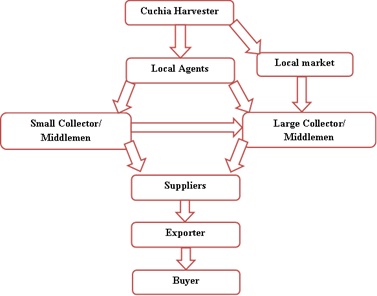 Figure 2: Typical marketing channel of mud ell.
Figure 2: Typical marketing channel of mud ell.
Pricing at various level of marketing chain
A different grading system was involved for price variation of marketing of freshwater eel in Bangladesh. It was varied according to the sex and size of the eel in the international market. In Bangladesh, above 100 g per individual eel were the marketable size, internationally sold in two size ranges; Small (50 g-250 g) and Large (above 250 g) in the study areas. Smaller mud eels had comparatively higher market price than those of larger one. There was a specific reason behind this. The smaller one is easy to process because it contains less amount of fat. So, smaller mud eels had greater preference among consumers. In addition to the small collector’s, large collectors, exporters play a significant role in uplifting of price and artificial crisis creating a complex chain resulted in the low price gained by the bottom leveled harvesters (Figure 3). But price of freshwater mud eel was not fixed; it was changed daily based on demand and supply. After marketing channel analysis of freshwater mud eel in the present study areas, it was found that price was controlled from buyer country. The buyer country fixed price through proprietors via various online media or cell phone. Proprietor told the price to the local agents over cell phone. Finally, the last selling price of the product was depended on the number of collectors, transport system and facilities, packaging cost and labor involvement; higher the distance higher the price.
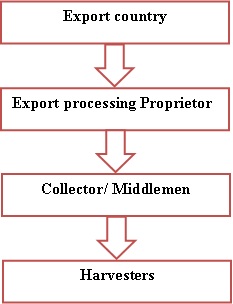 Figure 3: Flow chart of price control of mud eel in the study areas.
Figure 3: Flow chart of price control of mud eel in the study areas.
Monthly variation of mud eel in the study areas
The seasonal variation of availability of mud eel species was a normal phenomenon. It was remarkable that eel population in the water-bodies showed seasonality in their occurrence and harvesting. Mud eel as recorded in this section were more or less available round the year. Highest amount of collection was found in March to December and lowest was in January to February (Figure 4). The reasons of less amount of collection in January and February may be the collectors are busy with other works like harvesting of paddy, sowing other crops, preparation of land for cultivation etc. These months’ collectors take collection of mud eels as a part time work. Another reason may be the comparatively much lower temperature of these two months. Since mud eel is a poikilothermic animal, low temperature forces mud eels going deeper hole and in lethargic condition. From March to December there were no such problems, so collection going on in full swing and total amount of collection was higher. In March and April where collection was highest because of all collectors were engaged, water bodies got dried up and mud eels came out from its hole. The availability of mud eel varies from season to season depending on the extent of water flow and water depth, water availability, climatic conditions, reproduction and recruitment from natural stocks. With exceptions of a few occasions, eel was more or less available round the year. The Local agent collected mud eel from different harvesters. The findings showed that collectors collected highest amount of mud eel from Bogra in all 3 consecutive fiscal years (2015-16, 2016-17, 2017-18) and lowest from Rangpur district in the same time period (Figure 4). There are specific reasons behind this variation. Bogra district has larger floodplain areas among three districts of study area. Not only this but also the number of collectors of mud eel was higher in Bogra. These two reasons put Bogra top in the rank. Hasan et al. (2012) observed in Hatiya, Noakhali that the supply amount of freshwater eel from is 20-30 ton per month [6]. Most of the freshwater eel (65%) was found in winter season in Hatya, Noakhali. But in the Northern region of Bangladesh availability of mud eel was higher in post winter and prior to winter. In terms of annual collection, collection of 2017-18 fiscal years from these three districts is higher than that of fiscal year 2016-17 and 2015-16. That means the harvesting rate is increasing year after year.
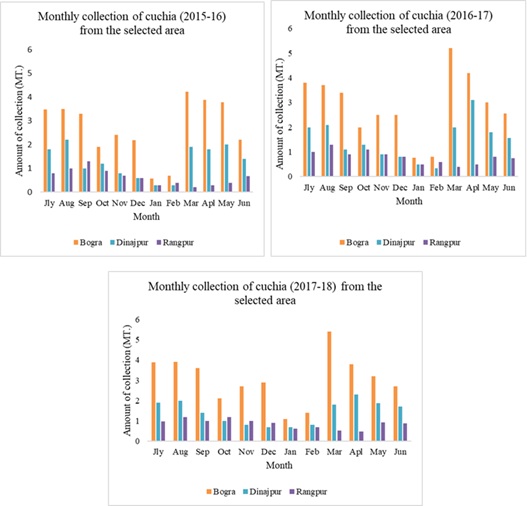 Figure 4: Total collection in the consecutive 3 fiscal years (2015-16, 2016-17 and 2017-18) from study area by the selected collectors.
Figure 4: Total collection in the consecutive 3 fiscal years (2015-16, 2016-17 and 2017-18) from study area by the selected collectors.
Invested on mud eel business in a year
High collection of mud eel needs more investment. The mud eel business men invested huge amount of money on the basis of availability and demand of mud eels. In the case study, the collectors invested total BDT 70,10,660 in mud eel business in July-2015 to June-2016 (Figure 5). August- September and March- April were the best time for mud eel business.
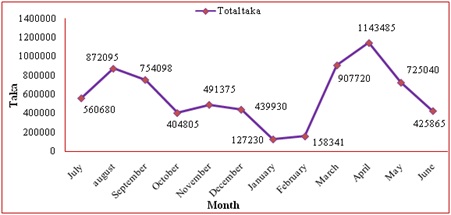 Figure 5: Investment on mud eel business in the fiscal year of July 2015 - June 2016 in the study area by the selected collectors.
Figure 5: Investment on mud eel business in the fiscal year of July 2015 - June 2016 in the study area by the selected collectors.
Profit of mud eel business in a year
This study revealed that freshwater eel marketing is a profitable business. The social and religious limit on consumption of freshwater eel was also reported as a problem that hinders the business and prevents obtaining realistic prices in the domestic. Large amount invested on mud eel got more profit in mud eel business. In the case study this collector’s profit from mud eel business total BDT 230840 in July, 2015 - June, 2016 (Figure 6). The local agents sell their product with 10 % profits to the suppliers or export processing zone. Price variation, lack of buyers and market information, credit problems, high mortality and poor transportation systems in the marketing of freshwater eel were observed. All of these problems have harmful effects on the international markets. To accomplish an efficient marketing system in a competitive manner it is necessary to identify the existing problems and to solve these. In Hatiya of Noakhali districts of Bangladesh where price varies according to daily demand and there are generally seasonal variations in prices with the highest in summer (March to May) and the lowest in winter (November to January), which is more or less similar to the present findings [6].
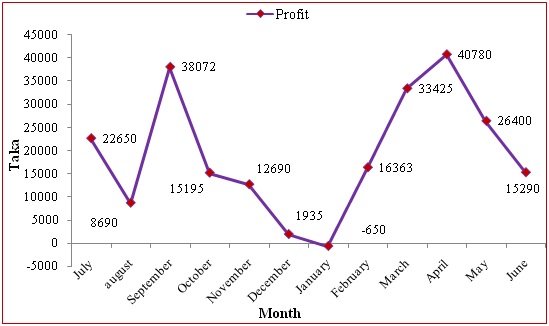 Figure 6: Profit of mud eel business in the fiscal year of July 2015 - June 2016 by the selected collectors.
Figure 6: Profit of mud eel business in the fiscal year of July 2015 - June 2016 by the selected collectors.
Limitations of Mud Eel Marketing
A number of limitations for fish marketing were recorded by suppliers, including poor communication facilities, social and religious limit in terms of consumption, higher labor cost, higher transport cost, poor supply of ice inadequate transport facilities and equipment, inadequate water supply, poor sanitary facilities and unhygienic condition and exploitation by middlemen as a result of lower market prices. The suppliers said that, political disturbances have also affected transportation as well as marketing. As a result, the perishable product of freshwater eel gets damaged and the suppliers sold these at cheap price in local market.
Processing of mud eels for exporting
Freshwater mud eels are exported in live condition. Some activities are done before exporting. A small processing is done in different processing areas before export. The data were collected from Uttara processing zone, Dhaka. Necessary instructions were given by foreign buyers on the basis of processing and packaging of the products through internet. The foreign buyers directly monitored each and every step by online through the Closed Circuit (CC) camera to ensure quality of the product. Unusually 8-10 skilled labors participated in each shift of processing. Processing started 4-5 hours before delivery. Dead and injured fish were removed in pre-possessing steps (Figure 7).
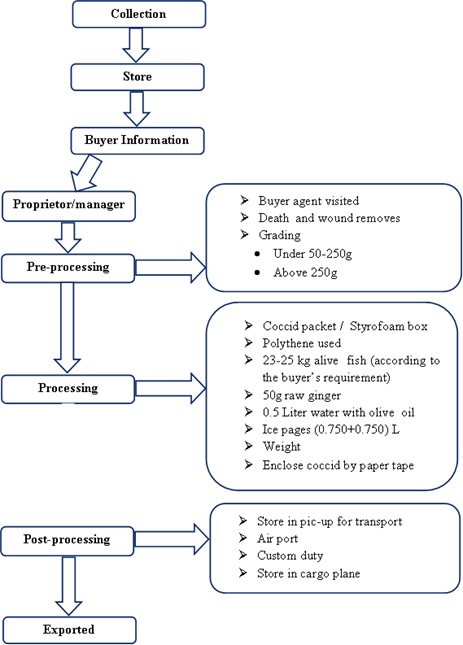 Figure 7: Flowchart showing different processing techniques of export-oriented mud ell followed at different marketing levels.
Figure 7: Flowchart showing different processing techniques of export-oriented mud ell followed at different marketing levels.
CONCLUSION
From the study, it is pretty clear that mud eel has a great potentiality being a one of the major export fishery products of Bangladesh. For expanding the local market of mud eel, we have to breach the religious limit and promote social awareness. Besides shorten the market chain, well equipped market facility should be prioritized. As availability of mud eels are decreasing day by day due to various natural and manmade causes. We have to capture it in a sustainable manner thus conservation of natural mud eel stock in nature is ensured. Government must take some obligatory steps to regulate the catching by imposing ban on harvesting brood mud eel as well as ban on peak breeding time and by fixing a minimum size of harvesting. Along with these, some large shallow water body must be reserved for year-round so that it could be used as breeding place for mud eels. Moreover, for greater good it is high time to develop scientific culture technique of mud eel as well as disseminate it in every possible area. In Bangladesh, effort of seed production of swamp mud eel in captivity has been started. Khan et al. (2016) has got initial success on seed production in their research [11]. Now it is necessary to develop a complete seed production method and a feasible culture technique that could be adopted at farmer levels. Capture, culture and marketing of mud eel could be a new paradigm to create job opportunity and uplift the living condition of poor people. Therefore, government and different nongovernmental organizations should take necessary steps in this regard.
REFERENCES
- Jhingran AG, Tawler PK (1991) Inland fisheries of India and adjacent countries. Oxford and IBH publishing co. Pvt. Ltd. Calcutta, India.
- Miah F, Naser MN, Ahmed MK (2015) The freshwater mud eel, Monopteros cuchia - a review. Journal of Global Biosciencesn 4: 1780-1794.
- Hossain MA, Islam MN (2007) Status and potentials of eel fisheries in Bangladesh. J Soil Nature 1: 46-51.
- Statistic Data (2018) Export Promotion Bureau (EPB) of Bangladesh. Dhaka, Bangladesh.
- Ahmed GU, Akter N, Nipa SA, Hosain MM (2009) Investigation on health condition of a freshwater eel, Monopterus cuchia from Aileebeel, Mymensingh, Bangladesh. Journal of the Bangladesh Agricultural University 7: 421-426.
- IUCN (2000) Red book of threatened fishes of Bangladesh. The world conservation union. Dhaka, Bangladesh. Pg no: 116.
- Hasan MM, Sarker BS, Nazrul KMS, Rahman MM, Mamunm A (2012) Marketing channel and export potentiality of freshwater mud eel (Monopterus cuchia) of Noakhali region in Bangladesh. International Journal of life Science Biotechnology and Pharma Research 3: 1-8.
- Chambers R (1992) Rural appraisal: Rapid relaxed and participatory. Institute of Development Studies, University of Sussex, Brighton, UK.
- Zafar M, Ahsan MN (2006) Marketing and value chain analysis of mud crab (Scylla) in the coastal communities of Bangladesh. Bangladesh Fisheries Research Forum. Pg no: 25-53.
- Rahman MM, Ahmed N (2003) Status of fish marketing in Gazipur, Bangladesh. MS Thesis, Department of Fisheries Management, Bangladesh Agricultural University, Mymensingh, Bangladesh.
- Khan MA, Rashid H, Fatema MK, Sukhan ZP, Hossain MAR, et al. (2016) First record of seed production of Swamp Mud Eel (Monopterus cuchia) by environment manipulation. Fisheries and Aquaculture News (FAN), Bangladesh Fisheries Research Forum 4: 24-27.
Citation: Islam T, Hossain F, Rana M, Sufian A, Rabbane G, et al. (2020) Marketing Channel of the Freshwater Mud Eels in Northern Region of Bangladesh and Its Pre-Export Processing Activities. J Aquac Fisheries 4: 026.
Copyright: © 2020 Md. Tamim Islam, et al. This is an open-access article distributed under the terms of the Creative Commons Attribution License, which permits unrestricted use, distribution, and reproduction in any medium, provided the original author and source are credited.

